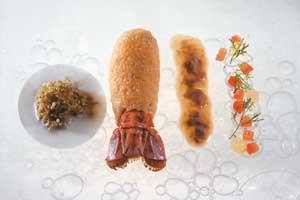Mimesis and Molecular Gastronomy: The Cognitive Dissonance of Food Art
Rachel Hite
The term “cognitive dissonance” refers to the discomfort felt when one notices a discrepancy between previously held beliefs and observed behaviors or circumstances — how we respond to new encounters that defy expectations built from past experience (click here for more). Put more simply, it deals with the pieces of knowledge we collect and how those pieces interact with one another (click here). Though we usually hear about cognitive dissonance in a psychological context as related to our own perceptions of ourselves, I want to think about it here in an aesthetic context as related to the idea of mimesis and molecular gastronomy, and how these instances of cognitive dissonance relate to food as art.
Mimesis, an idea dating back to Ancient Greece and Plato, refers to art that is imitative of some reality or reflective of nature. So, for example, a painting of a tree “mimics” an actual tree in nature. “Form,” when used in this same aesthetic context, refers to the action when the artist shapes some material according to his or her energies. These are not terms we normally encounter when talking about food, but how do they work together when talking about food as art? It is impossible to ignore any of these ideas, or their relationship to one another, when talking about Ferran Adrià and his incredible innovations in the world of haute cuisine.
Adrià, a native of Barcelona, is often hailed as the world’s greatest chef. His work is referred to as “molecular gastronomy,” a division of food science that explores the physical and chemical reactions that occur among ingredients while cooking. Additionally, this movement looks at the social and artistic implications of culinary phenomena. Though popular culture groups Adrià in this class, he actually prefers the term “deconstructionist,” believing that the primary motivation behind his work is deconstructing familiar forms and then reconstructing them and presenting the result to his diners in a new, unfamiliar, and what I often find to be a very beautiful way. The production, presentation, and consumption of Adrià’s work all occurs in the context of aesthetic experience, transforming the way in which the artistic creator and the artistic receiver experience the art object – in this case, food.
Consider one of his better-known dishes, called ‘mimetic peanuts.’ These so-called aren’t actually nuts at all, but are instead shells made of peanut oil that dissolve on your tongue leaving just the taste of peanuts rather than the texture. In this dish Adrià combines plays on form and mimesis with the idea of cognitive dissonance, giving the consumer a familiar look and taste with an unexpected texture. He seems keen on forcing these dissonant experiences, which in this case I would argue are pleasurable rather than disconcerting, on his audience. Other of his dissonant dishes include ‘caviar’ created through a scientific process transforming other foods into tiny egg-like spheres, and an apple cocktail that looks like a sandwich but dissolves in your mouth leaving only the flavor of the alcohol.
Adrià specializes in taking his art form to the extreme and creating unforgettable aesthetic experiences for the receivers of that art. As molecular gastronomy continues to grow and develop as a respected contribution to the world of culinary arts, I hope that good food in a broader sense will continue to become more respected as an art form. As Adrià himself says, “eating well is something you can do at home. The point about what [I] offer is that it is more than eating; it is an experience” (from article in The Observer) And a richly aesthetic one, at that.
Other articles from The Muse Dialogue
“The Aesthetics of Food” by Rachel Hite
“An Art Overlooked” by Andrew Swensen
“Food, Second Among the Arts” by Aaron Kagan













Trackbacks & Pingbacks